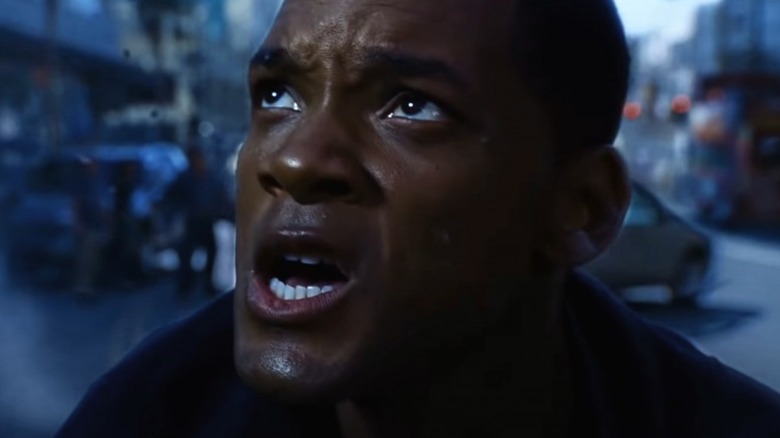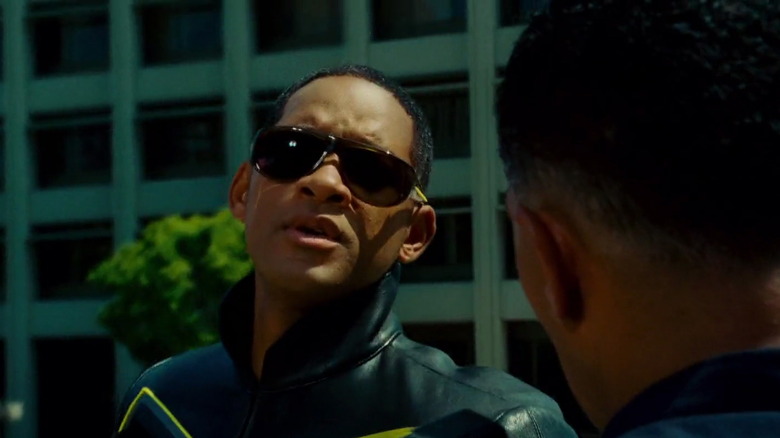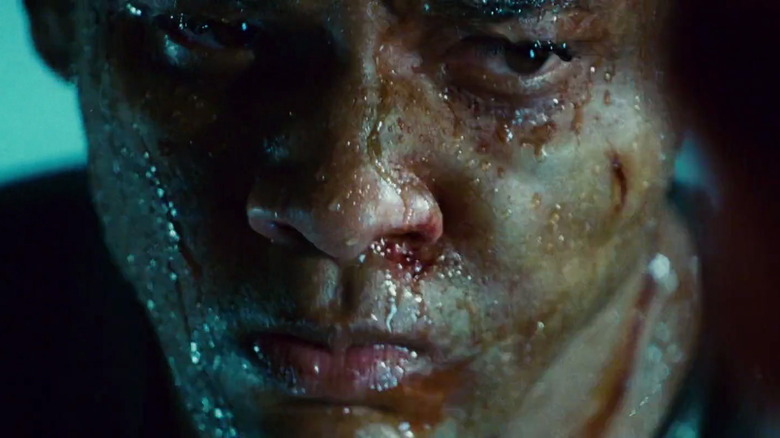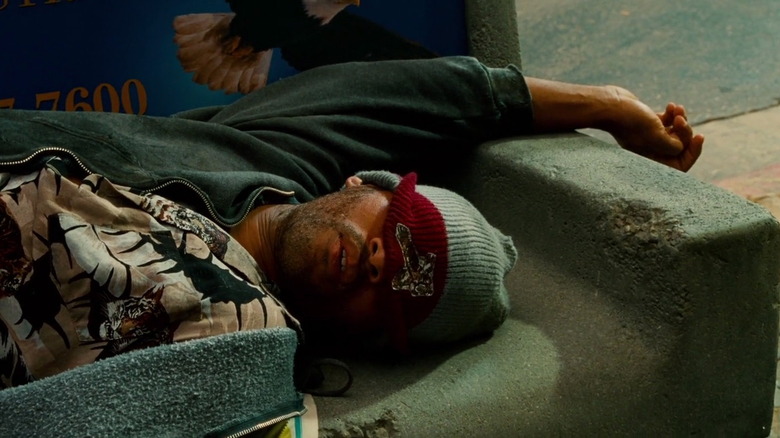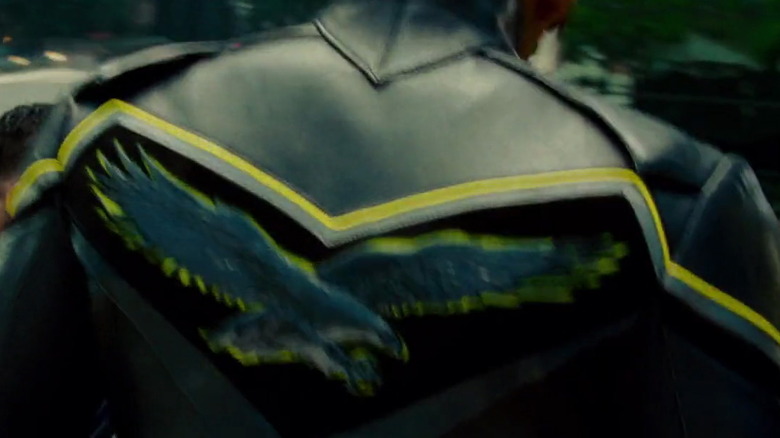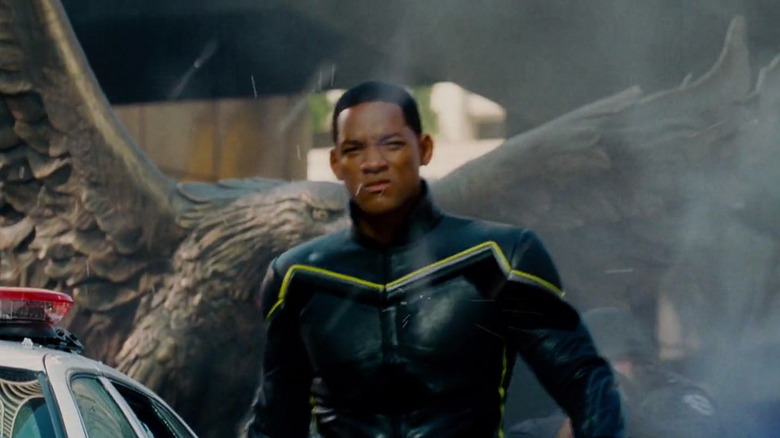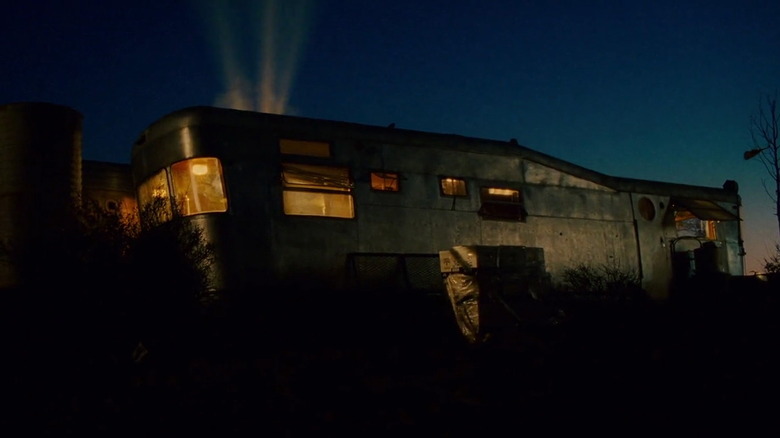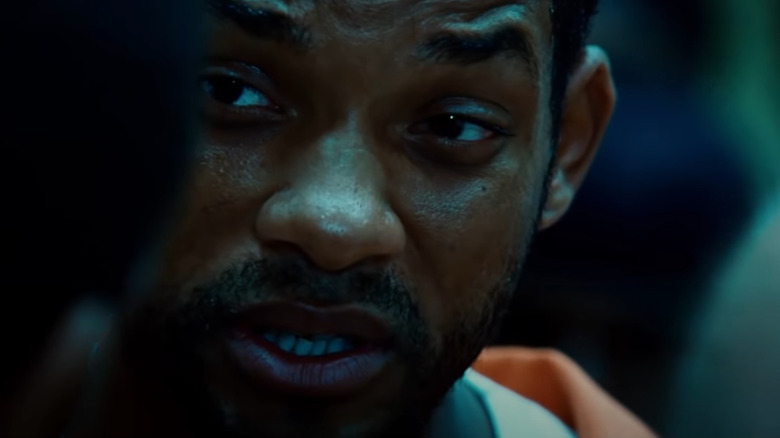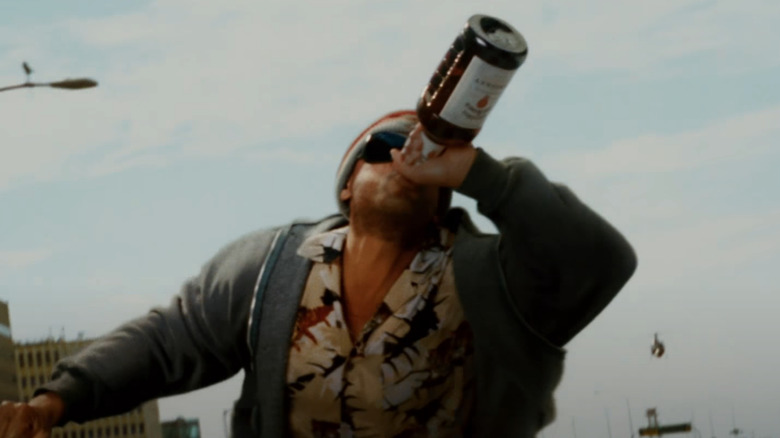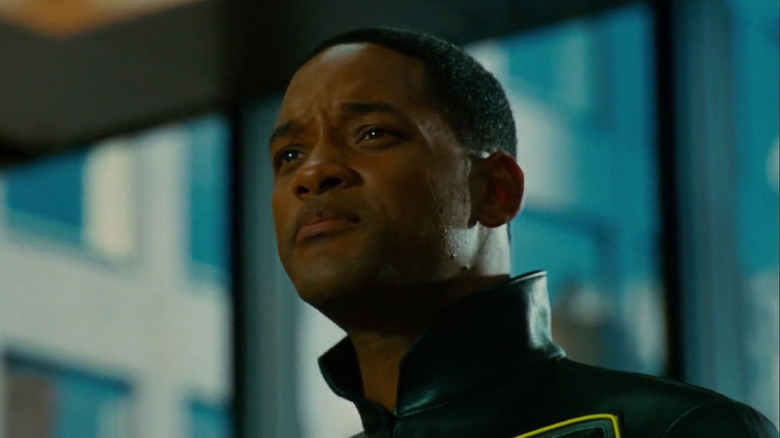The Untold Truth Of Hancock
The 2008 movie "Hancock" is from a forgotten era. An era when quality superhero movies were a rarity instead of the norm. When the Marvel Cinematic Universe was just taking its first steps with 2008's "Iron Man," far from the entertainment powerhouse it is today. When the alluring charm of superstar Will Smith was enough to guarantee any movie he starred in was a success. Those days, in many ways, are over.
Despite earning over $629 million worldwide and being the fourth highest-grossing film of its year, "Hancock" feels forgotten. It's true that "Hancock" took a beating in the reviews — currently 41% on Rotten Tomatoes — with critics being unsatisfied with the second half of the film, with its nonsensical "surprise twist" and lackluster villain (Eddie Marsan). However, "Hancock" was ahead of the curve in parodying the superhero genre before Marvel themselves mainstreamed the subversion to great success with films like "Deadpool" or "Guardians of the Galaxy." It's an informative film that shows the audience where Hollywood was at in understanding comic books and superheroes in general, exhibiting the lessons learned from failed comic book adaptations of the past while also making similar mistakes. Even taking into account Smith's star power, the success of "Hancock" is still worth praising for being an original movie about an irremediable hero trying to better himself. But there's a lot to the history of "Hancock" that even fans may be completely unaware of.
Why is he named John Hancock?
"Hancock" may seem like a generic name for a superhero, as well as a name for a big-budget movie starring Will Smith. The initial name for the project was "Tonight, He Comes," based on a spec script by Vy Vincent Ngo. However, before filming began, the movie was renamed to "John Hancock" in June of 2007, after director Peter Berg had boarded the project, one year before the film's release (per IGN). It was then shortened to "Hancock" in July of the same year (via Access Hollywood).
The choice of the name "Hancock" comes from when Smith's character, suffering from amnesia, is asked to give his "John Hancock" — his signature — but while the movie version has a nurse ask for a signature as the superpowered individual is released from the hospital, the original spec script has a scummy-looking clerk operating a sex-stained motel asking for his name.
The original script was dark, edgy, and unfilmable
"Hancock" had the makings of a blockbuster franchise. A funny, subversive superhero movie starring Will Smith, one of the most charismatic actors in Hollywood, in the lead role? Who could say no to a movie like that? Well, it turns out, "Hancock" was never intended to be the big, theatrical crowd-pleaser that it became.
The original spec script by Vy Vincent Ngo, titled "Tonight, He Comes" (the full version of which is online), was a much darker story about a near-irredeemable hero and the family unlucky enough to get involved in his life. While Hancock in the Will Smith version is a rude drunk, he's still a drunk with a heart of gold. The Hancock in "Tonight, He Comes" is a foul-mouthed, sex-addicted scumbag who drinks his pain away. Morally, what sets the two Hancocks apart is that the original version is a self-obsessed monster — he nearly rapes a woman from the family he forcibly integrates himself into, and he goes on a cop-killing spree when police attempt to rescue the mother figure from Hancock.
The concept, according to a New York Post interview with Dustin Nguyen, was a gritty, complicated, "real and challenging" take on Superman (per the New York Post). Considering the extreme content that would have given the film an R rating or worse — many called it unfilmable, according to the Post — it's understandable why "Tonight, He Comes" was softened up into the PG-13 "Hancock."
If you or anyone you know has been a victim of sexual assault, help is available. Visit the Rape, Abuse & Incest National Network website or contact RAINN's National Helpline at 1-800-656-HOPE (4673).
Hancock was in development hell
Before the Marvel Cinematic Universe conquered Hollywood, superhero movies were more hit-or-miss. Especially if the comic book movie was about an original superhero rather than an established one from Marvel or DC Comics. Doubly so if they were an edgy, sleazy hero beyond redemption. That's the challenge "Hancock" faced when Vy Vincent Ngo wrote the original script way back in 1996.
The initial script for "Tonight, He Comes" first caught the eye of Academy Award-winning screenwriter Akiva Goldsman, who helped the project attract several filmmakers through the years — Tony Scott ("Top Gun"), Michael Mann ("Heat"), Jonathan Mostow ("Terminator 3: Rise of the Machines"), and Gabriele Muccino ("The Pursuit of Happyness") — before landing with Peter Berg, then hot off of the success of "Friday Night Lights" and its television series and the Jamie Foxx vehicle "The Kingdom" (per Den of Geek). While various rewrites were done by writers like Vince Gilligan, of "Breaking Bad" fame, and John August, "Hancock" was still a hard R rating. It wasn't until Smith was signed on that the content softened to give the actor a better image (per Den of Geek). At the end of this turbulent development, "Hancock" was finally released in theaters in 2008 — 12 years after the spec script was written.
Hancock's logo is a reference to the Philadelphia Eagles
A superhero isn't a superhero unless they have a cool-looking logo to show off. Where would the Caped Crusader be if he didn't have his iconic bat emblem? How would Superman (Christopher Reeve) defeat Zod (Terence Stamp) in "Superman II" if he didn't throw his giant "S" shield at him? Well, when Hancock finally sobers up and becomes a professional superhero, his new costume sports a familiar image that longtime football fans would recognize in a heartbeat.
The image of the eagle on the back of Hancock's costume is reminiscent of the logo used for the Philadelphia Eagles from 1948 to 1995. It's the sort of subtle joke about corporate branding that "The Boys," released 11 years later, loves to do (via Decider). But eagles appear as a symbol throughout the film, too, not just in the costume design — he draws eagles in his cell, there's a huge statue of one outside the bank, and the hero has one on his hat. Given that Will Smith is a native of Philadelphia, this detail could have been a suggestion from the actor, or done as a tribute to him. Or maybe the costumers and production designers were just big fans of the Eagles. Either way, the eagle logo is a neat detail for the people of Philadelphia.
Hancock is the Egyptian god Horus
One theory about "Hancock" is that Will Smith's character is actually the human incarnation of the Egyptian god Horus. For starters, Hancock's eagle motif — which subtly appears throughout the movie, too — evokes the image of the falcon-headed god. Additionally, the Egyptian god Horus is often depicted wearing a pschent, a double crown consisting of red and white parts. Before cleaning up, Hancock's hobo outfit consists of a red and white beanie with an image of an eagle on it.
Even the movie's marketing suggests this identification of Hancock with Horus. Horus's eyes were said to be the sun and moon. The film's poster shows the sun reflecting off Hancock's sunglasses. The moon also plays an important part in the movie, as Hancock alters its surface to feature the heart logo of Ray Embrey (Jason Bateman).
This connection was part of the original draft. In that original script, the Ray-analog character was named Horus. So the Egyptian connection was there since the beginning.
Hancock nearly killed a one-night stand
The theatrical version of "Hancock" lacks the edgy black comedy of the spec script it's based on. It was given an R rating twice by the MPAA. But the theatrical cut nevertheless features a provocative scene that would have fit the raunchy tone of the original story.
In a surprising move, the MPAA actually cleared a scene where Hancock almost killed a woman during sexual intercourse with his explosive eja— let's say "energy." His explosive energy. (For more clarity, read Larry Niven's essay "Man of Steel, Woman of Kleenex.") A less intense version of this scene made the final cut. "This is about why Superman can't get a date," producer Akiva Goldsman said (per The New York Times). "The physical impracticalities of this, this is what we play with."
While this outrageous scene would be right at home in "The Boys," as written, the hero killing someone accidentally during a hookup wasn't determined to be the right tone for "Hancock," and so the scene was adjusted to make Will Smith's character more amiable. As director Peter Berg told Den of Geek, "It just wasn't that funny. ... Never was. You'd put it in front of an audience and there'd be two, maybe three people laughing. There was no way to do that and then regain even a modicum of emotional integrity."
The ratings board surprisingly didn't take issue with the butt scene
Perhaps the wildest moment in "Hancock" comes when Hancock agrees to go to jail for his misbehavior as a superhero. He is immediately harassed by all the criminals he put there in the past. The intimidating confrontation as all the criminals gang up on Hancock leads to the superhero threatening two criminals blocking his cell, "If you don't move, your head is going up his a**." Of course, Hancock was true to his word. The aftermath is equally funny, as a perplexed Ray Embrey asks Hancock, "Did you shove a man's head up another man's a**?" Hancock answers with a nod.
Director Peter Berg had to edit many jokes out of the film to appease the ratings board, but was the prison scene ever on the cutting board? "There's always a dance with the ratings commission," he told Pioneer Press. "They actually didn't have a problem with [the prison scene] because they deemed it physically impossible." As for the rest of the film, Berg described the editing process to The New York Times as "an epic game of chicken."
Not everyone loved the scene, though — some critics, such as Wesley Morris, writing for The Boston Globe, objected to the humor. "What does one say about a movie that wants laughs from a shot of one inmate's head up the derriere of another?" he wrote.
Real liquor brands didn't want to be in the movie
It's the job of a superhero to save those in need. It's also the job of the superhero to advertise the heck out of a promotional product featured in their films. Just take a look at the Tide ad for "Doctor Strange in the Multiverse of Madness." Or the infamous perfect shot of Sears in "Man of Steel."
For Hancock, however, the problem is that the movie is about an irresponsible superhero with an alcohol problem. The reason why Will Smith's character in the movie is constantly drinking from fake liquor brands named "Pap Smear Vodka" is because the real "brown-bag brands" didn't want their products in the movie (per The Los Angeles Times). Thunderbird and Night Train were two brands that refused to lend their names to the film, so the art department had to create booze bottles from fictional liquor companies instead (via The Los Angeles Times). Considering how youth-oriented superhero movies typically are, it's understandable why real liquor brands were afraid of seeing their products in a tentpole comic book film and being accused of advertising to children — also, the film's depiction of alcohol use isn't exactly glowing.
If you or anyone you know is struggling with addiction issues, help is available. Visit the Substance Abuse and Mental Health Services Administration website or contact SAMHSA's National Helpline at 1-800-662-HELP (4357).
Where's Hancock 2?
In this day and age when multiple superhero movies from Marvel and DC are being made annually, it's surprising that Sony has yet to release a sequel to "Hancock." Although the film may have received mixed reviews when it was originally released way back in 2008, the Will Smith vehicle grossed $629 million worldwide. So there clearly was an audience for a possible sequel.
After the film's success, director Peter Berg said he had plans for "Hancock 2" (per MTV). In 2009, Sony hired Adam Fierro and Glen Mazzara to pen a sequel, but that was the last official update from the studio (per MTV). Considering the development problems of the original film, it's not surprising that the proposed sequel is taking just as long to make, especially given that the landscape of superhero cinema has changed dramatically since 2008. The fate of "Hancock 2" is even more uncertain when factoring in Will Smith's Academy Award controversy of slapping Chris Rock after the comedian mocked Jada Pinkett Smith. "Hancock 2" may just remain a pipe dream.
